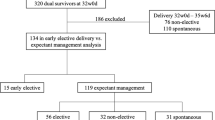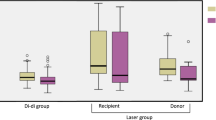Abstract
Objective
To assess the cardiac function and prevalence of congenital heart defects (CHD) in twin–twin transfusion syndrome (TTTS) survivors.
Study design
Prospective follow-up of TTTS pregnancies treated with laser surgery (2015–2018). Echocardiography was performed 1 day and 1 month after birth (corrected for prematurity). Results were compared with a control group of age-matched uncomplicated monochorionic twin-pairs at 1 month.
Result
Eighty-nine TTTS (168 neonates) and nine control pregnancies (18 neonates) were enrolled. CHD birth prevalence was 9.2% (8/87) in recipients and 13.6% (11/81) in donors (p = 0.37). Four of 19 (21%) were detected prenatally, all pulmonary stenosis. Donors had lower aortic peak velocities compared with recipients at day 1 (0.66 ± 0.15 m/s vs 0.71 ± 0.19 m/s, p = 0.04) and 1 month (1.04 ± 0.21 m/s vs 1.11 ± 0.18 m/s, p = 0.02), but not compared with controls.
Conclusion
CHD prevalence in TTTS survivors is high, with a low prenatal detection of minor abnormalities. Follow-up fetal echocardiograms and a postnatal echocardiogram should be offered.
This is a preview of subscription content, access via your institution
Access options
Subscribe to this journal
Receive 12 print issues and online access
$259.00 per year
only $21.58 per issue
Buy this article
- Purchase on Springer Link
- Instant access to full article PDF
Prices may be subject to local taxes which are calculated during checkout
Similar content being viewed by others
References
Best KE, Rankin J. Increased risk of congenital heart disease in twins in the North of England between 1998 and 2010. Heart. 2015;101:1807–12.
Habli M, Lim FY, Crombleholme T. Twin-to-twin transfusion syndrome: a comprehensive update. Clin Perinatol. 2009;36:391–416.
Moon-Grady AJ, Rand L, Lemley B, Gosnell K, Hornberger LK, Lee H. Effect of selective fetoscopic laser photocoagulation therapy for twin-twin transfusion syndrome on pulmonary valve pathology in recipient twins. Ultrasound Obstet Gynecol. 2011;37:27–33.
Gijtenbeek M, Shirzada MR, Ten Harkel ADJ, Oepkes D, Haak MC. Congenital heart defects in monochorionic twins: a systematic review and meta-analysis. J Clin Med. 2019;8:902.
Herberg U, Gross W, Bartmann P, Banek CS, Hecher K, Breuer J. Long term cardiac follow up of severe twin to twin transfusion syndrome after intrauterine laser coagulation. Heart. 2006;92:95–100.
Sueters M, Middeldorp JM, Vandenbussche FP, Teunissen KA, Lopriore E, Kanhai HH, et al. The effect of fetoscopic laser therapy on fetal cardiac size in twin-twin transfusion syndrome. Ultrasound Obstet Gynecol. 2008;31:158–63.
Barrea C, Hornberger LK, Alkazaleh F, McCrindle BW, Roberts A, Berezovska O, et al. Impact of selective laser ablation of placental anastomoses on the cardiovascular pathology of the recipient twin in severe twin-twin transfusion syndrome. Am J Obstet Gynecol. 2006;195:1388–95.
Gardiner HM, Taylor MJ, Karatza A, Vanderheyden T, Huber A, Greenwald SE, et al. Twin-twin transfusion syndrome: the influence of intrauterine laser photocoagulation on arterial distensibility in childhood. Circulation. 2003;107:1906–11.
Gardiner HM, Matsui H, Roughton M, Greenwald SE, Diemert A, Taylor MJ, et al. Cardiac function in 10-year-old twins following different fetal therapies for twin-twin transfusion syndrome. Ultrasound Obstet Gynecol. 2014;43:652–7.
Halvorsen CP, Bilock SL, Pilo C, Sonesson SE, Norman M. Childhood cardiac function after twin-to-twin transfusion syndrome–a 10-year follow up. Acta Paediatr. 2009;98:1468–74.
Halvorsen CP, Mohlkert LA, Norman M, Sonesson SE. Childhood cardiac outcome after intrauterine laser treatment of twin-twin transfusion syndrome is favourable. Acta Paediatr. 2015;104:252–8.
Herberg U, Bolay J, Graeve P, Hecher K, Bartmann P, Breuer J. Intertwin cardiac status at 10-year follow-up after intrauterine laser coagulation therapy of severe twin-twin transfusion syndrome: comparison of donor, recipient and normal values. Arch Dis Child Fetal Neonatal Ed. 2014;99:F380–385.
Breatnach CR, Bussmann N, Levy PT, Vincent DF, Malone FD, McCallion N, et al. Postnatal myocardial function in monochorionic diamniotic twins with twin-to-twin transfusion syndrome following selective laser photocoagulation of the communicating placental vessels. J Am Soc Echocardiogr. 2019;32:774–84.
Quintero RA, Morales WJ, Allen MH, Bornick PW, Johnson PK, Kruger M. Staging of twin-twin transfusion syndrome. J Perinatol. 1999;19:550–5.
Slaghekke F, Oepkes D. Solomon technique versus selective coagulation for twin-twin transfusion syndrome. Twin Res Hum Genet. 2016;19:217–21.
Middeldorp JM, Sueters M, Lopriore E, Klumper FJ, Oepkes D, Devlieger R, et al. Fetoscopic laser surgery in 100 pregnancies with severe twin-to-twin transfusion syndrome in the Netherlands. Fetal Diagnosis Ther. 2007;22:190–4.
Michelfelder E, Tan X, Cnota J, Divanovic A, Statile C, Lim FY, et al. Prevalence, spectrum, and outcome of right ventricular outflow tract abnormalities in twin-twin transfusion syndrome: a large, single-center experience. Congenit Heart Dis. 2015;10:209–18.
Greenough A, Milder AD. Pulmonary disease of the newborn. In: Rennie JM, editor. Textbook of neonatology. 4th ed. London, UK: Elsevier; 2005.
Lopez L, Colan SD, Frommelt PC, Ensing GJ, Kendall K, Younoszai AK, et al. Recommendations for quantification methods during the performance of a pediatric echocardiogram: a report from the Pediatric Measurements Writing Group of the American Society of Echocardiography Pediatric and Congenital Heart Disease Council. J Am Soc Echocardiogr. 2010;23:465–95.
Baumgartner H, Hung J, Bermejo J, Chambers JB, Evangelista A, Griffin BP, et al. Echocardiographic assessment of valve stenosis: EAE/ASE recommendations for clinical practice. J Am Soc Echocardiogr. 2009;22:1–23.
McMahon CJ, Feltes TF, Fraley JK, Bricker JT, Grifka RG, Tortoriello TA, et al. Natural history of growth of secundum atrial septal defects and implications for transcatheter closure. Heart. 2002;87:256–9.
Dragulescu A, Mertens LL. Developments in echocardiographic techniques for the evaluation of ventricular function in children. Arch Cardiovasc Dis. 2010;103:603–14.
Sutherland GR, Di Salvo G, Claus P, D’Hooge J, Bijnens B. Strain and strain rate imaging: a new clinical approach to quantifying regional myocardial function. J Am Soc Echocardiogr. 2004;17:788–802.
Al Akhfash AA, Almesned AA, Al Harbi BF, Al Ghamdi A, Hasson M, Al Habshan FM. Two-dimensional echocardiographic predictors of coarctation of the aorta. Cardiol Young. 2015;25:87–94.
van der Linde D, Konings EE, Slager MA, Witsenburg M, Helbing WA, Takkenberg JJ, et al. Birth prevalence of congenital heart disease worldwide: a systematic review and meta-analysis. J Am Coll Cardiol. 2011;58:2241–7.
Ciccone MM, Scicchitano P, Zito A, Gesualdo M, Sassara M, Calderoni G, et al. Different functional cardiac characteristics observed in term/preterm neonates by echocardiography and tissue doppler imaging. Early Hum Dev. 2011;87:555–8.
Van Mieghem T, Done E, Gucciardo L, Klaritsch P, Allegaert K, Van Bree R, et al. Amniotic fluid markers of fetal cardiac dysfunction in twin-to-twin transfusion syndrome. Am J Obstet Gynecol. 2010;202:e41–47.
Van Mieghem T, Lewi L, Gucciardo L, Dekoninck P, Van Schoubroeck D, Devlieger R, et al. The fetal heart in twin-to-twin transfusion syndrome. Int J Pediatr. 2010;2010.
Zikulnig L, Hecher K, Bregenzer T, Baz E, Hackeloer BJ. Prognostic factors in severe twin-twin transfusion syndrome treated by endoscopic laser surgery. Ultrasound Obstet Gynecol. 1999;14:380–7.
Pruetz JD, Sklansky M, Detterich J, Korst LM, Llanes A, Chmait RH. Twin-twin transfusion syndrome treated with laser surgery: postnatal prevalence of congenital heart disease in surviving recipients and donors. Prenat Diagn. 2011;31:973–7.
Tutar E, Ekici F, Atalay S, Nacar N. The prevalence of bicuspid aortic valve in newborns by echocardiographic screening. Am Heart J. 2005;150:513–5.
Siu SC, Silversides CK. Bicuspid aortic valve disease. J Am Coll Cardiol. 2010;55:2789–2800.
Karatza AA, Wolfenden JL, Taylor MJ, Wee L, Fisk NM, Gardiner HM. Influence of twin-twin transfusion syndrome on fetal cardiovascular structure and function: prospective case-control study of 136 monochorionic twin pregnancies. Heart. 2002;88:271–7.
van den Boom J, Battin M, Hornung T. Twin-twin transfusion syndrome, coarctation of the aorta and hypoplastic aortic arch: a case series report. J Paediatr Child Health. 2010;46:76–79.
Buyens A, Gyselaers W, Coumans A, Al Nasiry S, Willekes C, Boshoff D, et al. Difficult prenatal diagnosis: fetal coarctation. Facts Views Vis Obgyn. 2012;4:230–6.
Springer S, Mlczoch E, Krampl-Bettelheim E, Mailath-Pokorny M, Ulm B, Worda C, et al. Congenital heart disease in monochorionic twins with and without twin-to-twin transfusion syndrome. Prenat Diagn. 2014;34:994–9.
Cantinotti M, Lopez L. Nomograms for blood flow and tissue Doppler velocities to evaluate diastolic function in children: a critical review. J Am Soc Echocardiogr. 2013;26:126–41.
Feise RJ. Do multiple outcome measures require p-value adjustment? BMC Med Res Methodol. 2002;2:8.
Rothman KJ. No adjustments are needed for multiple comparisons. Epidemiology. 1990;1:43–46.
Fetal Echocardiography Task F, American Institute of Ultrasound in Medicine Clinical Standards C, American College of O, Gynecologists, Society for Maternal-Fetal M. AIUM practice guideline for the performance of fetal echocardiography. J Ultrasound Med. 2011;30:127–36.
Acknowledgements
We thank the parents of all twins who participated in this study. We also would like to thank those involved with the planning and performance of the postnatal echocardiograms. We want to pay special thanks to Fransisca de Klerk Voll and Gwen Timmermans Bos.
Funding
This study is funded by Canon Medical Systems Corporation, Otawara, Tochigi, Japan.
Author information
Authors and Affiliations
Contributions
Study conception and design: SJE, MCH, and ADJTH, data acquisition: all authors, analysis and data interpretation: MG and ADJTH, drafting of the manuscript: MG, critical revision: all authors.
Corresponding author
Ethics declarations
Conflict of interest
The authors declare that they have no conflict of interest.
Ethical approval
The study was approved by the medical ethical committee of the Leiden University Medical Center (NL 45251.058.13).
Informed consent
Written informed consent was obtained from the parents.
Additional information
Publisher’s note Springer Nature remains neutral with regard to jurisdictional claims in published maps and institutional affiliations.
Supplementary information
Rights and permissions
About this article
Cite this article
Gijtenbeek, M., Haak, M.C., Eschbach, S.J. et al. Early postnatal cardiac follow-up of survivors of twin–twin transfusion syndrome treated with fetoscopic laser coagulation. J Perinatol 40, 1375–1382 (2020). https://doi.org/10.1038/s41372-020-0645-x
Received:
Accepted:
Published:
Issue Date:
DOI: https://doi.org/10.1038/s41372-020-0645-x



